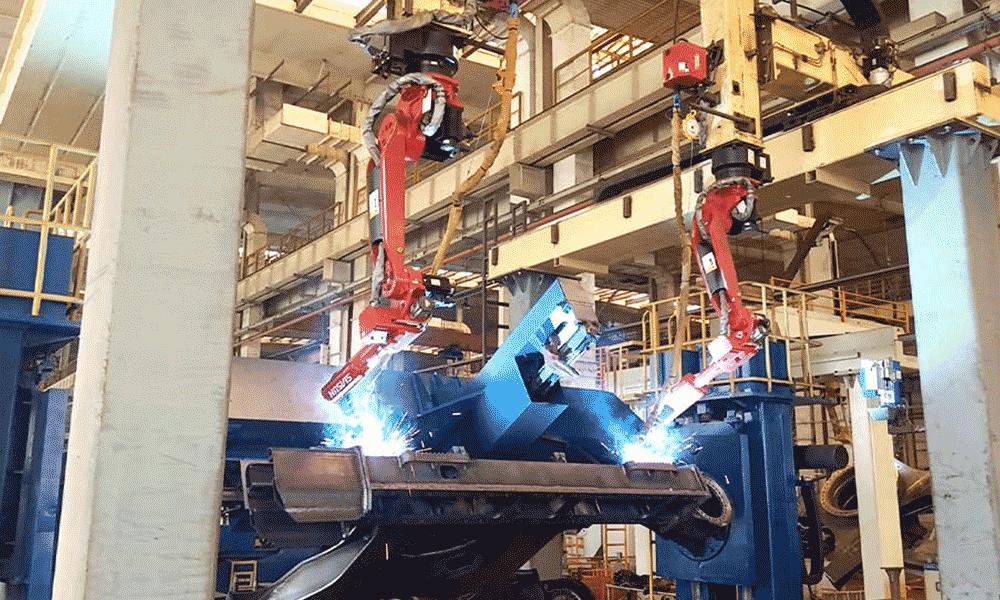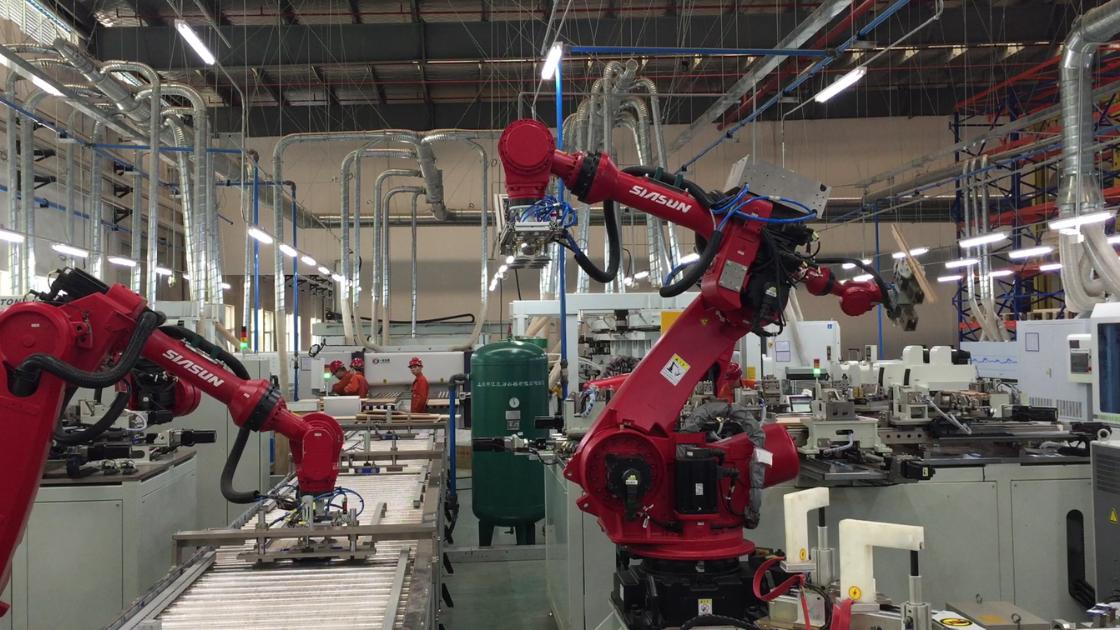TL;DR:
- Robotisation of welding workstations significantly improves the quality and precision of welding, eliminating human error.
- Automation reduces labour and material costs, reducing waste.
- Improves occupational safety by eliminating the risk of accidents associated with manual work.
- Initial implementation costs can be high, but they pay off through reduced errors and costs.
- Robotisation contributes to long-term economic benefits, increases the scalability of production.
- It has an impact on extending machine life and sustainability.
- It requires new skills from employees, which implies the need for training.
Do you want to discover how robotic welding workstations can revolutionise your production processes? With the increasing demand for precision and efficiency, robotic welding stations are becoming a key tool in the industry. As an expert, I will show you how these advanced technologies not only improve the quality of welds, but also significantly reduce operating costs, thereby improving workplace safety.
What are the main advantages of robotising welding workplaces?
The robotisation of welding workstations brings many benefits that are crucial for any modern production facility. First and foremost, you are probably wondering: How does robotisation affect weld quality? The answer is simple: it significantly improves the quality and precision of welding. The robots are programmed to repeat the same movements exactly, eliminating human error and ensuring uniformity in every weld. It is the perfect solution for series production, where quality plays a key role.
Savings in labour and material costs through automation
One of the most attractive aspects of robotisation is cost reduction. But does robotisation really save costs? Yes, because it reduces the number of workers needed to handle the welding process and minimises material waste. Welding robots use materials more efficiently, reducing production costs.
Increasing occupational safety and reducing the risk of accidents
Another benefit is increased safety in the workplace. Working in welding involves the risk of burns, eye damage and inhaling harmful fumes. With robotisation, these risks are greatly reduced as robots can perform these dangerous tasks for humans.
Every step towards automation that companies such as Michale, represents an investment in the future. Robotisation not only improves quality and safety, but also contributes to long-term savings, thereby increasing the company's competitiveness in the market.
Robotic welding station: key benefits
Thanks to the robotised welding workstations that are increasingly appearing on the shop floor, we can see significant benefits in various aspects of work. Robotisation in welding is not just a fashionable term, but a reality that brings with it a number of advantages, improving quality, efficiency and safety.
Improved welding quality and precision through robot technology
Welding requires incredible precision, and the robotisation of workstations is making this precision a daily reality. Robots equipped with modern sensors and advanced software are able to control every welding movement, minimising errors and increasing the repeatability of production. It is thanks to this that robotisation has an impact on the quality of welds, where every weld is made with the greatest attention to detail.
Savings in labour and material costs through automation
Automation of welding processes leads to significant savings. Welding robots can work non-stop, reducing human labour costs and reducing material waste, which contributes to lower material costs. Robotisation actually saves costs, offering companies the opportunity to invest in innovations that pay for themselves quickly.
Increasing occupational safety and reducing the risk of accidents
Safety in industry cannot be underestimated. With robotic welding workstations, workers can avoid dangerous tasks, reducing the risk of accidents. Robots, with their advanced technology and sensors, can operate in harsh environments, protecting people's health. This is a breakthrough in the industry that puts the welfare of workers first.
All these advantages of welding robotisation make it an indispensable part of modern production, benefiting both companies and the workers themselves.

What are the costs and benefits of implementing robots in welding?
When asked about the initial costs of implementing robotisation, the answer is that these investments can amount to hundreds of thousands of zlotys. However, much depends on the scale of implementation and the degree of technological advancement of the selected solutions. Various options are available on the market, from basic robotic workstations to highly automated production lines. At the same time, it is worth remembering that these initial outlays can quickly pay off. This is due to the reduction in labour and material costs. Thanks to automation, the risks associated with human error are also reduced, resulting in lower material losses.
Siasun welding robots, which are in the TOP3 robots in the world, pay for themselves in an average of 2 years counting the cost of a skilled worker. You must remember that the repeatability and quality of the robot's welds corresponds to the work of the best and at the same time most expensive welders on the market.
A Siasun welding robot with a welding machine costs between PLN 150-170,000, which is a price gap compared to competing robots costing more than PLN 400,000. If you would like to make an appointment to speak to our specialist we invite you to contact.
Analysis of long-term economic benefits
Robotisation brings long-term economic benefits. First and foremost, it increases production efficiency and scalability. Robotic welding stations run continuously, which maximises production. In addition, better weld quality reduces the need for rework, which lowers operating costs.
The impact of robotisation on machine life extension and sustainability
Introducing robots into welding processes can also extend the life of machines by optimising their use. Automated systems monitor the condition of machines, predicting failures and preventing unplanned downtime. In addition, sustainability benefits from automation through more efficient use of raw materials and waste reduction. I encourage you to explore this topic in greater depth through the full guide available on our blog.
How does robotisation affect the future of the welding industry?
The robotisation of welding workstations shimmers as the key to an industrial revolution. These workstations are not only changing the way we produce, but are also influencing the future of the welding industry. The key question is: what changes might occur in the future as a result of robotisation? The answer comes down to digital transformation, which is already accelerating the pace of change in factories around the world. Modern welding technologies enable precise, fast and efficient operations.
Opportunities and trends in modern welding technology
Automated welding systems do not just save money, but also offer production benefits. Imagine a robot that performs dozens of welds with consistent accuracy. This is a future that is already beginning to be realised today thanks to Michale. Robotisation enables the implementation of advanced algorithms and sensors, making processes more reliable. The infrastructure of such workstations allows integration with various IT systems, which further supports digitalisation.
Our experience in the construction of production lines is ideally suited to the implementation of entire welding workstations that we carry out for our customers.
Digitisation of industrial processes in welding
Is the future of the welding industry digital? Without a doubt, yes. The digitalisation of industrial processes, of which robotisation is a part, leads to better quality control, cost optimisation and increased production flexibility. Michale Automation is constantly at the forefront of this field, offering extensive welding systems that are able to integrate with global data networks. This gives customers access to real-time data analysis, which is key to making accurate production decisions.
Impact on staff competence and need for training in robotisation
Robotisation also requires new skills from employees. The introduction of advanced technology means that continuous competence development becomes necessary. Michale, recognising this need, invests in training and professional development, allowing employees to adapt to dynamic technological changes. These changes bring new career opportunities and open the door to innovative solutions that will shape the future of the welding industry.
Summary
In summary, robotisation of welding workplaces significantly improves the quality and precision of welds, while reducing labour and material costs. Work safety is increased, thanks to a reduction in the risk of accidents. Modern sensor and software technologies integrate processes, increasing production efficiency. Despite the initial investment costs, the long-term benefits far outweigh them, supporting sustainability. The future of the welding industry is digitalisation and adaptation to innovative technologies, which requires us to continuously develop our skills. Robotisation is the key to an edge in the modern industrial world.

